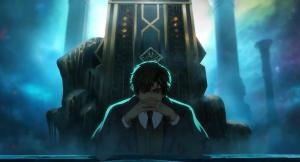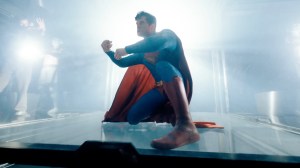A character who possess the soul of a man, but the appearance of a monster. A narrative defined in equal parts by mad scientists attempting to play god and the supernatural mysteries to which they aspire. Themes of self-determination and questioning one’s role in the universe. Am I discussing the story of Hellboy or Frankenstein’s monster (henceforth referred to as Frankenstein)? It’s hard to tell.
Videos by ComicBook.com
Given that comparison, it’s hard to believe that it has taken this long for Mike Mignola to incorporate Mary Shelley’s classic gothic vision into his massive tapestry of modern horror. Frankenstein plays upon so many of the same tropes and concepts as Hellboy, but is capable of expanding these ideas in an entirely different direction. Whereas Hellboy was always intended for a very specific purpose, Frankenstein is a creation who was brought into this world simply to exist. Hellboy must confront beliefs of pre-destination, while Frankenstein is confronted with existential ennui. It is this difference that defines Frankenstein Underground #1 and makes it instantly obvious that the inclusion of Frankenstein within the “Mignola-verse” was inevitable.
The first issue, written by Mignola and drawn and colored by Ben Stenbeck and Dave Stewart, respectively, is set after a chance encounter between Frankenstein and Hellboy in Mexico in 1956. Frankenstein has been chased into the countryside by a populace that fears and hates him once more. There he discovers an old woman who, like him, has been forced to abandon society due to her supernatural qualities. Everything is not allowed to remain peaceful for long as outside forces seek to capture and control Frankenstein.
Mignola’s plotting is direct and to the point. He wastes no time dragging out convoluted back stories; they certainly exist, but will emerge naturally through the story itself. The script resembles the best of his work on stories in Hellboy or Baltimore, establishing characters and conflict with ease. While Frankenstein Underground #1 may be based within a pre-existing universe, this is a true number one issue that allows for easy access and consumption.
That shouldn’t be mistaken for simplicity or plainness though. Mignola and Stenbeck are obviously both lovers of their chosen genre and character, and play to the thematic strengths of these concepts. There are strains of Lovecraft and Mignola’s own creations embedded within Frankenstein Underground #1, but its heart is that of a gothic horror novel brought forth into the 20th century (when Shelley’s novel was first widely embraced). Purpose, secrecy, monstrosity: These are familiar chords woven together into the first movement of a comics symphony.
Stenbeck encapsulates Frankenstein’s origins and ongoing plight beautifully into an origin sequence that takes only a few pages to tell. A quick series of panels compose a montage of conflicts in which Frankenstein was engaged, each of them bookended by a single descriptive word and a caption for the setting. The first panel reveals Frankenstein hiding behind a tree as soldiers march past him through the forest. The only words needed are a solitary “hunted” and the time and place: “Macedonia, 1826”. This progression not only details Frankenstein’s elongated life and vast travels, but summarizes his personal experience. Stenbeck composes each panel to capture the essence of the moment. Whether Frankenstein is hunted, fought, or caged, his feelings of fear, anger, and despair are what dominate the panel. Even as Frankenstein’s origin becomes more verbose and linear in nature, Stenbeck masterfully selects each moment in order to best create a sense of empathy with the monstrous-looking man.
This is made all the more powerful by the way in which Stenbeck’s presentation of these moments contrasts with Mignola’s narration. Frankenstein details his life to the woman who has helped him, but he understates many of the depicted events. His anguish in some panels is left out of his words to be only hinted at by a melancholy tone. This places reader’s in Frankenstein’s position as they are made aware of his personal knowledge and the active choices he makes in revealing or concealing it. It makes Frankenstein a more sympathetic protagonist, and helps to convey his morality as he reflects on terrible moments with a clear sense of shame.
Stenbeck and Mignola take full advantage of this sympathy to make Frankenstein’s fears and angers those of the reader. As he lashes out at a chaotic and uncaring universe, that rage feels real. The exaggerations of the genre are no match for a story that is written and presented based on real human experience. Death and loss are not obfuscated by the inclusion of monsters and mysteries, instead they are heightened. As Frankenstein Underground #1 gives way to darkness, it feels like an invitation to continue exploring the struggles of a character grappling with very real existential woes.
Stewart has refined his craft as a colorist on horror comics for almost two decades into an absolute mastery of the form (deservedly earning him 8 Eisner awards). His colors in a Mignola comic tend to skew dark, but his palette in Frankenstein Underground #1 is even more oppressive than usual. Every sequence occupied by Frankenstein is dominated by blacks that push down on his world. He is in a cave at night and Stewart ensures that the story feels just as dark as it should without obscuring Stenbeck’s line work and storytelling. It is a daunting experience that reinforces the reader’s connection with Frankenstein. The final panel of the issue speaks volumes to both the story it presents and the keen choices of Stewart and Stenbeck in presenting that story.
Frankenstein Underground #1 has introduced another element to Mignola’s every expanding pantheon of horror and adventure comics. It fits in perfectly alongside the likes of Hellboy, B.P.R.D., Baltimore, Sledgehammer ’44, and all of the others, but never feels like an unnecessary mirror to any of its sister titles. Instead, Frankenstein Underground plays on similar concepts and themes, but sets itself up to explore them in a manner that feels entirely new. Mignola and Stenbeck are prepared to delve into the existential quandaries of existence and the horrors of a universe that is so massive as to dwarf even Frankenstein’s enormous form. Frankenstein Underground is a series worth looking out for in 2015.
Grade: B+
Frankenstein Underground #1 will be published by Dark Horse Comics on March 18, 2015.










